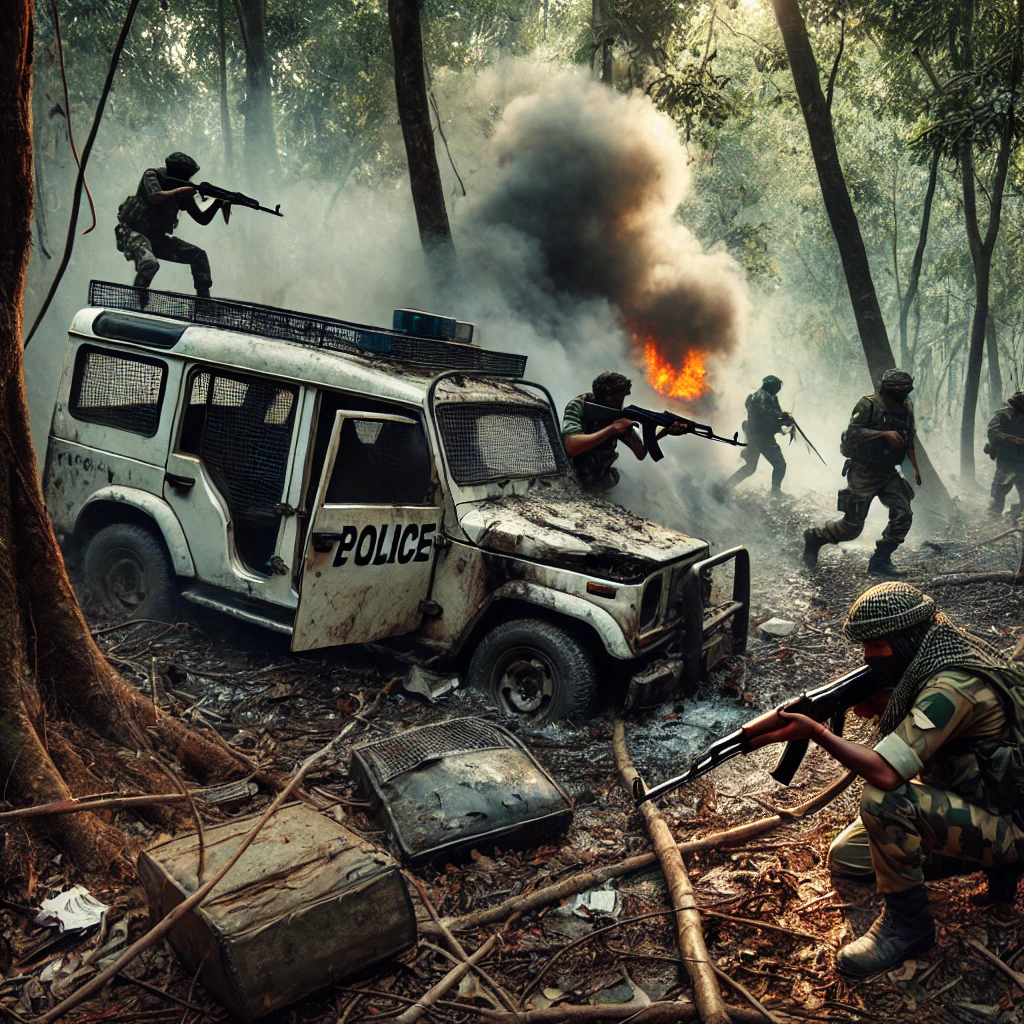On January 6, 2025, a devastating attack in the heart of Chhattisgarh’s Bijapur district left nine security personnel dead, as Naxalites blew up a police vehicle returning from an encounter. The tragic incident highlights the growing concerns of Naxal insurgency in India’s central regions, particularly in Chhattisgarh, a state that has long been a battleground between state forces and Maoist rebels.
The Incident
The attack occurred on the Bedre-Kutru Road, a known hotspot for Naxal activities. A group of District Reserve Guard (DRG) personnel from Dantewada, along with a civilian driver, were returning after a joint operation involving forces from Dantewada, Narayanpur, and Bijapur. The security vehicle, a Scorpio, was targeted by an improvised explosive device (IED) planted by the insurgents. The blast left eight jawans and the driver dead.
This attack is being seen as one of the most significant assaults on security forces in the region in recent years, underlining the persistent threat posed by the Naxalites. While such incidents are not new to Chhattisgarh, this attack comes at a time when efforts to curb insurgency and bring peace to the region remain ongoing.
The State of Naxalism in Chhattisgarh
Chhattisgarh has been at the epicenter of Naxalite violence in India for over a decade. The state’s dense forests and remote villages provide ideal conditions for Maoist insurgents to establish hideouts and training camps. The Naxalites, who adhere to a radical left-wing ideology, aim to overthrow the Indian state and replace it with a communist government. Their ideology advocates for the empowerment of the rural poor, and they draw support from marginalized communities. However, their methods of violence and coercion have led to widespread destruction and loss of life, both among security forces and civilians.
The state’s security forces, including the Central Reserve Police Force (CRPF), the DRG, and other paramilitary units, have been engaged in counterinsurgency operations for years to suppress the Naxal movement. Despite these efforts, the insurgents have shown remarkable resilience, using guerrilla tactics, ambushes, and IEDs to cause maximum damage to security forces. The recent attack on the DRG personnel is a stark reminder of the ongoing battle and the challenges faced by law enforcement in the region.
The Impact of the Attack
The attack on January 6 is not just a tragic loss of life; it also has far-reaching consequences for the security dynamics in the region. Firstly, it highlights the continued vulnerability of security personnel operating in Naxal-affected areas. Despite intelligence inputs and counterinsurgency strategies, insurgents are still able to carry out such deadly strikes, indicating that the Naxals maintain a strong presence in the area.
Secondly, the attack raises questions about the effectiveness of existing counterinsurgency measures. While there have been successes in curbing the influence of the Naxalites in certain areas, the insurgents continue to strike at will. This points to a possible gap in intelligence gathering and the inability to anticipate such attacks. The Naxals’ use of IEDs, in particular, has been a deadly tactic, and despite the efforts to neutralize these weapons, they remain a significant threat to security forces.
Finally, such attacks also have a psychological impact on the local population and law enforcement. The constant threat of violence not only instills fear but also undermines the trust that local communities may have in state institutions. In some cases, this fear and distrust can lead to a lack of cooperation with security forces, further complicating efforts to combat the insurgency.
The Response of Security Forces
Following the attack, Chhattisgarh’s Chief Minister, Bhupesh Baghel, condemned the incident and expressed his condolences to the families of the victims. The state government promised to take all necessary measures to ensure justice for the fallen soldiers and to further strengthen counterinsurgency operations. Authorities also launched a search operation in the area to track down the Naxalites responsible for the attack.
The security forces have long been working to address the root causes of Naxalism, focusing on both military and socio-economic solutions. While military operations aim to neutralize insurgents, efforts to improve infrastructure, education, and healthcare in remote areas are also crucial in addressing the underlying grievances that fuel the insurgency. However, these efforts require significant resources, coordination, and time, and the presence of armed insurgents complicates the process.
The Role of Naxalism in India’s Political Landscape
Naxalism, often considered the most significant internal security threat to India, has had a profound impact on the country’s political landscape. The insurgency has prompted extensive debates about the balance between security and human rights, the effectiveness of military responses, and the role of development in combating extremism.
On one hand, security forces argue that the use of force is necessary to combat a violent insurgency that destabilizes regions, disrupts governance, and endangers civilians. On the other hand, human rights organizations have criticized the heavy-handed approach of security forces, citing allegations of extrajudicial killings, arbitrary arrests, and displacement of local populations.
The Indian government has also been working on a long-term strategy to address the socio-economic conditions that fuel Naxalism. This includes improving governance, providing jobs, and ensuring basic services in tribal and rural areas. However, the effectiveness of these measures has been questioned, and the insurgents continue to attract recruits by exploiting local grievances.
Moving Forward: Challenges and Solutions
The attack in Chhattisgarh serves as a grim reminder that the Naxalite insurgency is far from over. While the Indian state has made significant strides in curbing the influence of the Naxals, much work remains to be done. A multi-pronged approach is necessary to address both the military and non-military aspects of the conflict.
- Intelligence Gathering and Technology: The use of advanced surveillance and intelligence-gathering technology can help preempt attacks and track the movements of insurgents. Drones, satellite imaging, and increased human intelligence are critical components of counterinsurgency operations.
- Strengthening Local Law Enforcement: Local police forces need to be trained and equipped to handle insurgent threats effectively. Collaboration between state and central agencies is also essential for a coordinated response.
- Development Initiatives: Economic development is key to undermining the Naxalites’ support base. Focused efforts on creating job opportunities, improving education, and ensuring better healthcare in Naxal-affected regions can help address the root causes of the insurgency.
- Community Engagement: Building trust between security forces and local communities is vital. Community policing, dialogue with tribal leaders, and providing security to civilians can help reduce the Naxals’ influence.
Conclusion
The attack on January 6, 2025, serves as a tragic reminder of the ongoing struggle in Chhattisgarh and other Naxal-affected areas. The Naxalite insurgency continues to challenge the Indian state, but with the right combination of military force, development, and community engagement, there is hope that this violence can eventually be brought to an end. However, given the deep-rooted nature of the issue, it will require sustained effort and patience from all stakeholders involved to achieve lasting peace in the region.














